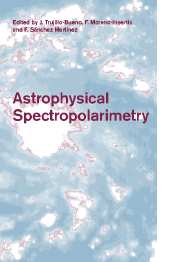Book contents
- Frontmatter
- Contents
- Participants
- Group Photograph
- Preface
- Foreword
- Acknowledgements
- The Physics of Polarization
- Polarized Radiation Diagnostics of Solar Magnetic Fields
- Polarized Radiation Diagnostics of Stellar Magnetic Fields
- Polarization Insights for Active Galactic Nuclei
- Compact Objects and Accretion Disks
- Astronomical Masers and their Polarization
- Interstellar magnetic fields and infrared-submillimeter spectropolarimetry
- Instrumentation for Astrophysical Spectropolarimetry
Polarized Radiation Diagnostics of Stellar Magnetic Fields
Published online by Cambridge University Press: 21 May 2010
- Frontmatter
- Contents
- Participants
- Group Photograph
- Preface
- Foreword
- Acknowledgements
- The Physics of Polarization
- Polarized Radiation Diagnostics of Solar Magnetic Fields
- Polarized Radiation Diagnostics of Stellar Magnetic Fields
- Polarization Insights for Active Galactic Nuclei
- Compact Objects and Accretion Disks
- Astronomical Masers and their Polarization
- Interstellar magnetic fields and infrared-submillimeter spectropolarimetry
- Instrumentation for Astrophysical Spectropolarimetry
Summary
The main techniques used to diagnose magnetic fields in stars from polarimetric observations are presented. First, a summary of the physics of spectral line formation in the presence of a magnetic field is given. Departures from the simple case of linear Zeeman effect are briefly considered: partial Paschen-Back effect, contribution of hyperfine structure, and combined Stark and Zeeman effects. Important approximate solutions of the equation of transfer of polarized light in spectral lines are introduced. The procedure for disk-integration of emergent Stokes profiles, which is central to stellar magnetic field studies, is described, with special attention to the treatment of stellar rotation. This formalism is used to discuss the determination of the mean longitudinal magnetic field (through the photographic technique and through Balmer line photopolarimetry). This is done within the specific framework of Ap stars, which, with their unique large-scale organized magnetic fields, are an ideal laboratory for studies of stellar magnetism. Special attention is paid to those Ap stars whose magnetically split line components are resolved in high-dispersion Stokes I spectra, and to the determination of their mean magnetic field modulus. Various techniques of exploitation of the information contained in polarized spectral line profiles are reviewed: the moment technique (in particular, the determination of the crossover and of the mean quadratic field), Zeeman-Doppler imaging, and least-squares deconvolution. The prospects that these methods open for linear polarization studies are sketched.
- Type
- Chapter
- Information
- Astrophysical Spectropolarimetry , pp. 101 - 150Publisher: Cambridge University PressPrint publication year: 2001
- 6
- Cited by

